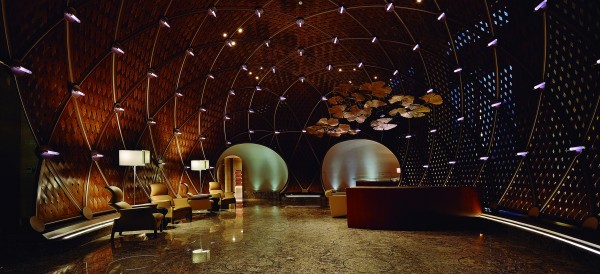It is a restless intersection located in one of the busiest area in Taipei City, Taiwan; around the corner stands a luxurious but quiet construction with an entrance resembles in an egg knitted by steel and wooden materials. This is Runtex Tun-Rein Residence, a symbol of sophisticated taste and prestige. The most recognizable feature of this building is exactly its egg-shaped structure installed in the lobby. To illuminate its distinguished design, lighting designers from CMA Lighting Design (CWI Lighting Design then), Ta-Wei Lin, Su-Chen Wu and Jamie Liu brainstormed.
-

-
Ruentex Tun-Rein Residence Lobby
Concept and requirement
The lobby is an 11x15-meter, 7-meter-high room and the three-dimensional “egg” is constructed by a steel pipe structure and covered with woven wooden slats. Before you walk into the egg, “the tongue,” a long, oval-shaped structure, welcomes you to enter this extraordinary building. When sunlight shining in during the day, you can see a woven pattern inside the lobby. The architects hoped to keep this unique style that enabled people to have a dramatic glance into it during the night, and they denied using any halogen or incandescent lamps for they preferred an energy-saving system.
Henceforth, the task of the lighting designers, on the one hand, was to recreate this elegant atmosphere during the night using soft lighting with a degree of shadow. On the other hand, they had to figure out how to apply energy-saving lighting fixtures – LEDs – and make them warm and soft. The TONGUE and the EGG were both most appealing features so owner and architects possessed high standards toward them, hoping to have a fascinate face all day long in a elegant and energy saving way.
-

-
Interior design of the "egg" -- cigar lights points inwards or outwards.
Challenges and Solutions
The lighting design process set up in 2004 when LEDs were not as flexible as they are now so it was not a pleasant job to search for adequate lighting fixtures aside from halogen or incandescent lamps. Besides, the egg couldn’t be over lit like a lantern because it would destroy the engaging beauty and the quietly luxurious style; nonetheless, it was also unacceptable to leave it dark for it is the front door of the 27 storey condominium. In order to satisfy owner and architects’ requirements, Ta-Wei Lin and his colleagues endeavored to search for perfect solutions.
For a better simulation, architects built a 1:1 egg mockup in another vacant room for lighting designers to do their tests. They tried out LEDs and CDM for a warm and energy saving lighting method in the beginning. Although they finally sought to create a space lit with LED fixtures, CDM was unattachable because its temperature was too high for the wooden material. Fortunately, they adopted another product which expressed a suitable color and temperature – 12W PAR30 LED lamps.
There are totally four types of LED fixtures in the lobby: Belt Lights, Down Lights, Cigar Lights and Sculpture Lights. The ambient light is provided by Belt Lights and Down lights; the previous one was created at the bottom of the egg to light up the structure softly while the latter one were Par 30-type 12W LED fittings installed in the ceiling. Sculpture Lights highlight specific focal points in the space and “Cigar” Lights, the most significant type, accentuate the unique form of the egg.
-

-
The "tongue" in front of the entrance. You can see the egg in the lobby illuminated by specifically designed lighting fixtures.
Tongue and Cigars
The entrance is typically constituted by two major entering images: the tongue and the egg. The glass-made tongue is an arcade placed between the main street and the entrance, it therefore marks the entrance of this luxurious building. To illuminate the glass canopy, the lighting designers hid LED strip lights (3000, 24W per meter) inside the structure to light the white glass on. Meanwhile, MR16 20W CDM down lights were employed to sufficiently light the entrance.
For the egg, the lighting designers had tried several methods before they found their final solution – a series of “cigar.” 155 Cigar Lights, lamps shaped like cigars, were installed linearly on the interior side of the egg. These lighting fixtures not only gave the lobby a fashionable impression, but also a surrealistic atmosphere. These 20cm-long cigars were created by metal plates and sat at each joint of the structure; there was a 3000K 1W LED inserted in every metal base and each of them was a partial sandblasted clear acrylic tube. Around half among the 155 cigars point inwards while the other half point outwards. This special idea created an effect that allowed people to see the egg’s form yet looked inside clearly. Additionally, they give directions for people who walk into this space.
-

-
The "cigar" light.
Photo Credit: CMA Lighting Design Inc.
In the end, this project had met almost every requirement from the owner and the architects. The energy consumption of the lobby is 14.7W/per square meter and 94% of the wattage used in the lobby comes from LED. Even almost every lighting fixtures are LEDs, there is still a warm feeling like lit by incandescent lamps.
Awards
-
2010 Award of Merit, IIDA
-
2009 Nominated for Best New Design at PLDC Berlin
















